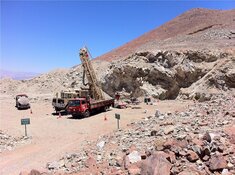John Licata: I think this is a great time to get back into the gold market. The recent slide is a buying opportunity. We are still facing a very challenging economic environment as evidenced by recent remarks by various U.S. Federal Reserve speakers, including Chairman Ben Bernanke. I think the concerns regarding deflation are completely overblown. The fact that we're seeing higher energy prices is an inflationary tidbit that's getting left on the sidelines by investors. Higher inflation will definitely lift gold prices, and the renewed strength in the euro vs. the dollar is a bullish factor for gold prices too. And we're quickly approaching Indian wedding season, which starts in September; that has historically been a bullish time for gold prices. And, in recent years, many of the gold producers have not really had any big finds, which also bodes well for gold because there is less gold to go around.
TGR: Will the senior producers look to takeovers to boost their gold reserves?
JL: I think adding capacity through mergers and acquisitions (M&A) can be cheaper than finding more gold. Commodities in general have become a unified marketplace. By that, I mean the opportunities to increase capacity, reserves or output are better served through M&A.
When Barrick Gold Corporation (NYSE:ABX; TSX:ABX) announced late last year that they would spend billions to buy back their hedge book, I think that indicated the gold price would continue to move higher. If the largest gold producer on the planet is getting rid of its hedges, obviously there is much more upside opportunity in the gold price.
TGR: Do you see some specific takeover targets out there?
JL: It's my opinion that NovaGold Resources Inc. (NYSE.A:NG; TSX.V:NG) is a takeover target. If companies like Barrick or Newmont Mining Corp. (NYSE:NEM) are looking to expand their portfolios, I think that NovaGold, with its Donlin Creek and Galore Creek gold projects, becomes even more attractive in a rising economy.
I think companies making acquisitions are more open to diversifying their portfolios. It's not so farfetched to see a company like Lonmin Plc (OTCBB:LMNIY), which is based overseas, getting involved in the Canadian or the North American gold markets. I wouldn't be surprised to see uranium companies purchasing gold assets given that uranium has been stagnant for the last couple of years.
Diversification will be key. Companies that did not have diversification in their portfolios will look for more diversification. I think NovaGold presents a very compelling opportunity, both from a valuation and asset-play perspective.
TGR: Will some suitors stay away from NovaGold because of potential permitting problems, given that their main project is in Alaska and has a fair number of opponents?
JL: No, I don't think so. And unlike the oil industry, the repercussions to the environment are greatly lower for mining than for offshore drilling. Right now, it takes many years to go through the permitting process. I think a lot of that has been improving. Alaska is a very interesting place because of its rich mineral deposits, as well as the oil that's there. A lot of commodities have become intertwined. I wouldn't be surprised if you saw a lot of different, unique, joint ventures going forward. And I don't think Alaska is going to be left in the cold.
TGR: In 2009, you called for $1,200 gold, and it hit $1,227 in December. How high are you willing to go this time around? And what's the timeframe?
JL: I have a $1,375 target on gold this year; it's a forecast I put out at the beginning of 2010. I'm still very comfortable with that forecast. We still have a long way to go before the end of the year. The fact that gold prices are still high compared to historical standards means that we've had an opportunity to sell off multiple times in recent months. Yet, we've always managed to find gold buyers on dips, and we're still hovering around $1,200. I think the sellers had their chance to drive down the price of gold and they're out. The 5% decline that we've seen in the gold price was not met by increased selling pressure—it was met by buyers looking for a cheap way to play the yellow metal. That $1,375 is still very much achievable this year.
TGR: What other gold companies have piqued your interest?
JL: Interestingly enough, I came across a company called Nautilus Minerals Inc. (TSX:NUS), and I thought it was really, really fascinating considering that it's mining minerals offshore. We often speak of offshore drilling as it applies to oil and gas, but you can use similar technology for deepwater metals mining.
TGR: They haven't started mining yet, though?
JL: Possibly by the end of this year, whether we're talking about offshore Papua New Guinea or New Zealand, they could have some positive assessments on some of their mineral properties that could perhaps attract JVs with companies like Halliburton Co. (NYSE:HAL) or Schlumberger Ltd. (NYSE:SLB). And maybe one of those companies could apply the same technology and expertise they have developed in offshore oil and gas drilling.
TGR: I should let our readers know that we're talking about the Solwara 1 in Papua New Guinea. It's a high-grade gold deposit that's around 4,500 feet below surface in the Pacific Ocean. To me, that seems fraught with unnecessary risk. Why do you like it given all that risk?
JL: Well, I think the permitting process has become more favorable for Nautilus in those regions. The new technology that Nautilus has developed to drill on the ocean floor—I believe it was 80 meters—makes this a much more attractive story. A lot of competitors have said they're going to enter this space, but I think Nautilus is ahead of them by a few years. The fact that companies like Teck Resources Ltd. (NYSE:TCK; TSX:TCK.A; TSX:TCK.B) and Anglo American Plc (NASDAQ:AAUK) are shareholders in Nautilus is very significant. What this company is embarking on could forever change the landscape of mining as we know it.
TGR: I agree, but I think it's much easier to bring liquids or gases to the surface vs. solids. What are some other gold plays you're following?
JL: In the past, I've talked about Fronteer Gold Inc. (TSX:FRG; NYSE.A:FRG); that's a company I am still enthusiastic about. I like the fact that they have exposure to uranium and I have had the pleasure of meeting management on several occasions. I am confident in their ability to execute their strategy. I think that from a valuation perspective, this company has a lot of upside.
TGR: You mentioned management. When you analyze different companies, where do you rank management?
JL: Management is very high in my list. As an analyst, I think I need to go the next step to find out what makes a company tick; it's my opinion that management is the heart and soul of a company. If they're not able to share their story or execute on a game plan, then that management should be replaced—as we have recently seen with BP (NYSE:BP; LSE:BP) replacing Tony Hayward with Robert Dudley. There's a very low tolerance for failure at the corporate level. It's extremely important to have a capable management team that instills confidence in not only shareholders but in analysts like myself.
TGR: What do you think of NovaGold's management?
JL: I am actually meeting with NovaGold president and CEO Rick Nieuwenhuyse next week in New York. I think Rick has done a great job of assembling a solid institutional base. Hedge Fund Manager John Paulson made an investment several months ago. Rick was very—what's the right word?—persistent in his pursuit of establishing a group of shareholders that thinks long term. He's done a good job of getting in front of Wall Street. I am looking forward to meeting him in person.
TGR: What are your thoughts on silver versus gold?
JL: It's funny, we talk about gold so much but we don't hear anything about silver. I think silver is very interesting from a historical perspective and how it has traded in concert with gold. In my eyes, silver is the evil stepchild of gold; and if gold prices move towards that $1,375 level, it's hard not to think that silver prices will go along for the ride. If you believe that we're going to have an economic recovery, then you have to look at silver because silver is used in so many products and new technologies.
TGR: Are there some silver companies that you like?
JL: I've always liked Hecla Mining Co. (NYSE:HL). It's unfortunate that investors have challenged them because of their location—its stock is down about 20% year to date. If you want some exposure to asset plays in Mexico, Hecla Mining could be a very interesting name.
In the past, I've talked about Pan American Silver Corp. (TSX:PAA; NASDAQ:PAAS)—another name that's down for the year—but it pays a small dividend. It is considered one of the bellwethers of the silver group. When you have a company that is perceived to be a major silver player with a market cap of only $2.6 billion, it makes me think the consolidation that I mentioned earlier is going to be felt across the entire commodities spectrum.
TGR: Moving to other precious metals, platinum and palladium prices move in tandem with global auto sales due to the amount of these metals used in catalytic converters. What are the prospects for those metals in light of the current global economic climate?
JL: I think palladium could see more upside. Many auto companies are moving toward cleaner standards in terms of emissions. That benefits palladium and platinum. Over the next couple of years, the entire auto market is going to change. A testament to that is that Tesla Motors, Inc. (NASDAQ:TSLA), an electric car company, just went public. I think companies that use palladium and platinum for catalytic converters are going to vie for supply contracts. Unlike the energy sector wherein there is an excess supply of natural gas, there is a very limited global supply of platinum and palladium.
TGR: What are some platinum and palladium companies you like?
JL: Stillwater Mining Company (NYSE:SWC) is a name I have talked about for a few years. They have a very interesting opportunity to change their game plan at this point; because at the end of 2010, their contract with Ford expires. I guess they were able to cultivate a new approach with General Motors, and they were successful. I think Wall Street was waiting for them to do the same with Ford. If the Ford deal does not go through, I believe the company can still be quite successful because many Japanese automakers would probably jump at the chance to have Stillwater supply their much-needed platinum and palladium. Stillwater is one of the most dominant players in those metals in North America.
TGR: What other metals show some potential?
JL: I think uranium is a forgotten metal. This goes back to what I mentioned earlier—it's no longer just an energy market. It's no longer just a metals market. It's just one commodities market. Uranium is a fascinating story—if we're talking about building nuclear reactors and having cleaner, more efficient energy sources, uranium falls into the category of metals that can do very well going forward.
TGR: Any companies in that space that you're particularly interested in?
JL: Cameco Corp. (NYSE:CCJ; TSX:CCO) is a company that, in the past, has been an M&A-opportunity hunter. It's my view that the hunter will become the hunted, and I wouldn't be surprised if we see an Asian company look at Cameco as a very attractive takeover target.
TGR: You think Cameco will be taken over?
JL: Yep.
TGR: That would be remarkable; that's a major uranium producer.
JL: Yes, it's a major. For the last few years, the company's share price has been somewhat suppressed because people wanted to determine the fallout from Cigar Lake's underground flooding. Now that the company is closer to putting that behind it, foreign companies looking to beef up their uranium presence will be much more receptive to looking it. Because Asian investors were so enthusiastic to purchase Canadian oil sands assets, I think there will be a run at Cameco now. A deal could face large regulatory challenges, but I think Cameco is a takeover target.
TGR: Well, that's certainly some interesting speculation. Any thoughts you would like to leave us with today?
JL: I will say when it comes to metals—and I've said this before—China is not the saving grace for commodities. If you plan to get into any metal based on China's prospective growth, I just don't think that's the right strategy. I think you need to look at commodities from a global perspective; and while it's great that China is improving, any slowdown in the Chinese market will have an enormous ripple effect throughout the rest of the world. But that doesn't mean the rest of the world economies won't grow and come out of what is arguably the worst recession since the Great Depression.
John J. Licata is chief commodity strategist at Blue Phoenix, Inc., an energy/metals independent research and consulting firm based in New York City. He has appeared regularly in the media (CNBC, Bloomberg TV/Radio, Business News Network, Barron's, etc.) over the years for his insights and forecasts in the commodity spectrum.
After studying economics and graduating from Saint Peter's College (where he received The Wall Street Journal Award for economic excellence), Licata set his sights on Wall Street. During his more than 15-year career, John has held both trading and research positions on the NYMEX, Dow Jones and Smith Barney. Early in 2005, he founded Blue Phoenix, a leading independent research and consulting firm focused on energy and metals. John is also the Editor of The Commodity Chronicles, the Blue Phoenix energy and metals newsletter (click here to receive a 30-day trial membership). John is currently in the EMBA program at New York University's Stern School of Business, and was recently voted "Up and Comer Natural Gas Analyst" in the 2010 Institutional Investor All-America Research Team Poll. You can follow John on Twitter and LinkedIn.
Want to read more exclusive Gold Report interviews like this? Sign up for our free e-newsletter, and you'll learn when new articles have been published. To see a list of recent interviews with industry analysts and commentators, visit our Expert Insights page.
DISCLOSURE:
1) Brian Sylvester of The Gold Report conducted this interview. He personally and/or his family own none of the companies mentioned in this interview.
2) None of the companies mentioned in the interview are sponsors of The Gold Report: None.
3) John Licata—I personally and/or my family own the following companies mentioned in this interview: None. I personally and/or my family am paid by none of the companies mentioned in this interview: None.










































